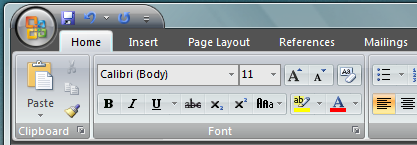

Microsoft took a brave step with the 2007 version of Office and decided to replace tool bars and menus with a single ‘ribbon’.
The ribbon is in effect a tabbed tool bar with large context-aware icons that show you more interactively what will happen when you use them and put the various options and selections right in there. It’s a concept I find that works very well indeed although some reviewers have been less enthusiastic.
Jensen Harris, Group Program Manager of the Microsoft Office User Experience Team, has been blogging about the forthcoming UI changes for some time but only recently dropped the bombshell.
Microsoft believe they own this concept and will license it to you for free providing you don’t compete with them.
If you’re not familiar with the history of computing or have been bombarded with FBI-copyright-warnings since birth you might think this is perfectly reasonable. The core problem however is that graphical user interfaces, like much of human endeavor, has been an iterative process of refinement and the concepts need to be free for the next iteration to happen.
Or, as Sir Isaac Newton said
If I have seen a little farther than others, it is because I have stood on the shoulders of giants.
The ribbon would be nothing without the developments that came before it. The tool bar, the tab, the icon or going back even further the window, the mouse and the document model.
Microsoft invented none of these things nor do they license them from somebody else indeed the whole concept of suing over “Look and Feel” died back with Apple’s failure to get a judgment over Microsoft for Windows borrowing UI concepts and Lotus also failing with their 1-2-3 interface being used in by Borland in their Quattro product.
The United States copyright and patents offices typically understand how damaging copyright on human interaction can be and indeed this is why a typeface (font) is not actually copyright-able. (TrueType, PostScript and OpenType font files *are* copyright-able but only because they contain a list of instructions – a program – to rendering the font).
Much of the common GUI we see today started with a special group at Xerox Parc which was then copied by the likes of Apple, Digital Research, IBM, Amiga, Next, Acorn and indeed Microsoft.
If you could patent basic user-interface concepts for 50 75 years either Xerox or Apple would be the only people able to produce such a graphical interface (depends on how water-tight Apple’s license with Xerox was).
You could likely say goodbye to scroll-bars, tabs, docks, dragging, drop-down menus, tear-off menus, recycle bins, radio buttons and other plethora of concepts we’ve gained along the way as they’d be little incentive to innovate when the government has given you the exclusive right to basic concepts.
I can’t help but wonder if this whole thing kicked off because Creative believe they own the idea of a very simple menu as used in the iPod and indeed are trying to sue Apple about it.
[)amien
2 responses
Yeo, I wish this was surprising, but it's really not anymore. Companies are increasingly doing this, standing on the shoulders of giants and then trying to claim that their incremental change is a revolutionary new idea that deserves protection from competition. Bollocks is all I can say.
I listen to a heck of a lot of podcasts which mainly focus on tech news and for a long time it has always been a 50% split between what is new in terms of products and rest is about who is getting sued. In fasct it seems more and more like the legal stuff is the news.
The thing that gets me about all this is the fact that with one hand companies like Microsoft (and they are not the only ones) will sue for something like this ribbon and then on the other hand they will make every effort to copy something (like the zune and the ipod).